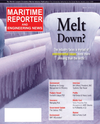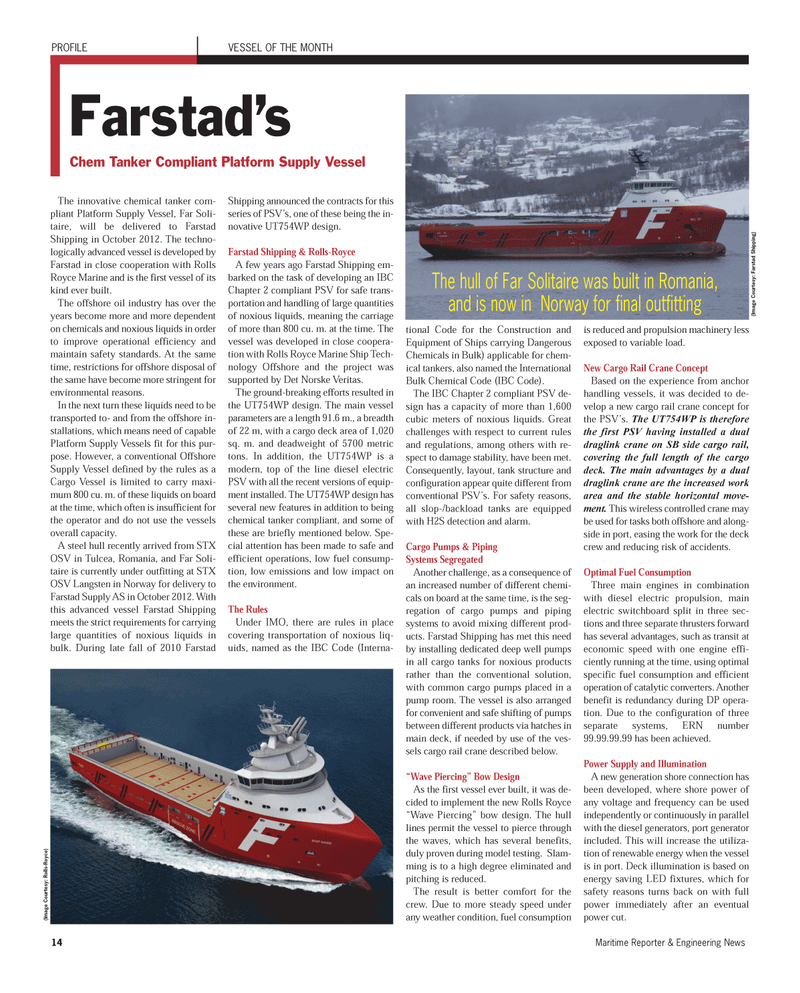
Page 14: of Maritime Reporter Magazine (May 2012)
The Green Ship Edition
Read this page in Pdf, Flash or Html5 edition of May 2012 Maritime Reporter Magazine
14Maritime Reporter & Engineering News PROFILEVESSEL OF THE MONTHFarstad?s Chem Tanker Compliant Platform Supply Vessel The innovative chemical tanker com- pliant Platform Supply Vessel, Far Soli- taire, will be delivered to Farstad Shipping in October 2012. The techno- logically advanced vessel is developed by Farstad in close cooperation with Rolls Royce Marine and is the first vessel of its kind ever built. The offshore oil industry has over the years become more and more dependenton chemicals and noxious liquids in orderto improve operational efficiency and maintain safety standards. At the same time, restrictions for offshore disposal of the same have become more stringent for environmental reasons. In the next turn these liquids need to be transported to- and from the offshore in- stallations, which means need of capablePlatform Supply Vessels fit for this pur- pose. However, a conventional Offshore Supply Vessel defined by the rules as a Cargo Vessel is limited to carry maxi- mum 800 cu. m. of these liquids on boardat the time, which often is insufficient for the operator and do not use the vessels overall capacity. A steel hull recently arrived from STX OSV in Tulcea, Romania, and Far Soli- taire is currently under outfitting at STX OSV Langsten in Norway for delivery to Farstad Supply AS in October 2012. With this advanced vessel Farstad Shipping meets the strict requirements for carryinglarge quantities of noxious liquids in bulk. During late fall of 2010 Farstad Shipping announced the contracts for thisseries of PSV?s, one of these being the in- novative UT754WP design. Farstad Shipping & Rolls-Royce A few years ago Farstad Shipping em- barked on the task of developing an IBC Chapter 2 compliant PSV for safe trans-portation and handling of large quantities of noxious liquids, meaning the carriageof more than 800 cu. m. at the time. The vessel was developed in close coopera- tion with Rolls Royce Marine Ship Tech- nology Offshore and the project was supported by Det Norske Veritas. The ground-breaking efforts resulted in the UT754WP design. The main vessel parameters are a length 91.6 m., a breadthof 22 m, with a cargo deck area of 1,020 sq. m. and deadweight of 5700 metrictons. In addition, the UT754WP is amodern, top of the line diesel electricPSV with all the recent versions of equip- ment installed. The UT754WP design has several new features in addition to being chemical tanker compliant, and some of these are briefly mentioned below. Spe- cial attention has been made to safe andefficient operations, low fuel consump- tion, low emissions and low impact on the environment. The RulesUnder IMO, there are rules in placecovering transportation of noxious liq- uids, named as the IBC Code (Interna- tional Code for the Construction andEquipment of Ships carrying DangerousChemicals in Bulk) applicable for chem-ical tankers, also named the International Bulk Chemical Code (IBC Code).The IBC Chapter 2 compliant PSV de-sign has a capacity of more than 1,600cubic meters of noxious liquids. Greatchallenges with respect to current rulesand regulations, among others with re- spect to damage stability, have been met. Consequently, layout, tank structure and configuration appear quite different from conventional PSV?s. For safety reasons, all slop-/backload tanks are equippedwith H2S detection and alarm.Cargo Pumps & Piping Systems Segregated Another challenge, as a consequence ofan increased number of different chemi- cals on board at the same time, is the seg- regation of cargo pumps and piping systems to avoid mixing different prod- ucts. Farstad Shipping has met this need by installing dedicated deep well pumpsin all cargo tanks for noxious products rather than the conventional solution, with common cargo pumps placed in a pump room. The vessel is also arranged for convenient and safe shifting of pumps between different products via hatches in main deck, if needed by use of the ves- sels cargo rail crane described below. ?Wave Piercing? Bow Design As the first vessel ever built, it was de- cided to implement the new Rolls Royce ?Wave Piercing? bow design. The hull lines permit the vessel to pierce through the waves, which has several benefits, duly proven during model testing. Slam- ming is to a high degree eliminated and pitching is reduced. The result is better comfort for thecrew. Due to more steady speed under any weather condition, fuel consumption is reduced and propulsion machinery lessexposed to variable load. New Cargo Rail Crane Concept Based on the experience from anchor handling vessels, it was decided to de- velop a new cargo rail crane concept for the PSV?s. The UT754WP is therefore the first PSV having installed a dualdraglink crane on SB side cargo rail,covering the full length of the cargo deck. The main advantages by a dual draglink crane are the increased work area and the stable horizontal move- ment.This wireless controlled crane maybe used for tasks both offshore and along- side in port, easing the work for the deck crew and reducing risk of accidents. Optimal Fuel ConsumptionThree main engines in combinationwith diesel electric propulsion, mainelectric switchboard split in three sec-tions and three separate thrusters forward has several advantages, such as transit at economic speed with one engine effi- ciently running at the time, using optimalspecific fuel consumption and efficient operation of catalytic converters. Another benefit is redundancy during DP opera- tion. Due to the configuration of three separate systems, ERN number99.99.99.99 has been achieved. Power Supply and Illumination A new generation shore connection has been developed, where shore power of any voltage and frequency can be used independently or continuously in parallelwith the diesel generators, port generatorincluded. This will increase the utiliza- tion of renewable energy when the vessel is in port. Deck illumination is based onenergy saving LED fixtures, which for safety reasons turns back on with fullpower immediately after an eventual power cut. (Image Courtesy: Farstad Shipping) (Image Courtesy: Rolls-Royce) The hull of Far Solitaire was built in Romania, and is now in Norway for final outfittingMR May 12 # 2 (9-16):MR Template 4/24/2012 4:45 PM Page 14

 13
13

 15
15
